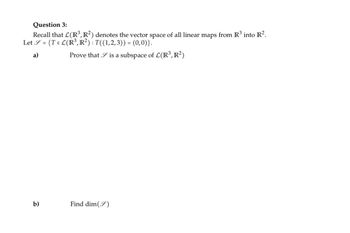
Advanced Engineering Mathematics
10th Edition
ISBN: 9780470458365
Author: Erwin Kreyszig
Publisher: Wiley, John & Sons, Incorporated
expand_more
expand_more
format_list_bulleted
Question
Solve problem 3

Transcribed Image Text:**Question 3:**
Recall that \(\mathcal{L}(\mathbb{R}^3, \mathbb{R}^2)\) denotes the vector space of all linear maps from \(\mathbb{R}^3\) into \(\mathbb{R}^2\).
Let \(\mathcal{S} = \{ T \in \mathcal{L}(\mathbb{R}^3, \mathbb{R}^2) : T((1,2,3)) = (0,0) \} \).
a) Prove that \(\mathcal{S}\) is a subspace of \(\mathcal{L}(\mathbb{R}^3, \mathbb{R}^2)\).
b) Find \(\dim(\mathcal{S})\).
![### Linear Algebra Problem: Injectivity of \(S\) Given an Invertible Composition \(T \circ S\)
**Problem Statement:**
Let \( V \) be a vector space over \( \mathbb{R} \), and let \( T, S : V \rightarrow V \) be linear maps from \( V \) into \( V \). Suppose \( T \circ S \) is invertible. Prove that \( S \) is injective.
**Solution Outline:**
To prove that \( S \) is injective, we need to show that if \( S(v) = S(w) \) for some \( v, w \in V \), then \( v = w \).
1. **Given that \( T \circ S \) is invertible, there exists a linear map \( (T \circ S)^{-1} \) such that:**
\[
(T \circ S) \circ (T \circ S)^{-1} = I_V
\]
where \( I_V \) is the identity map on \( V \).
2. **Assume \( S(v) = S(w) \).**
3. **Apply \( T \) to both sides of the equation:**
\[
T(S(v)) = T(S(w))
\]
This simplifies to:
\[
(T \circ S)(v) = (T \circ S)(w)
\]
4. **Since \( T \circ S \) is invertible, apply \( (T \circ S)^{-1} \) to both sides:**
\[
(T \circ S)^{-1}((T \circ S)(v)) = (T \circ S)^{-1}((T \circ S)(w))
\]
Which simplifies to:
\[
v = w
\]
Hence, \( v = w \) implies that \( S \) is injective, completing the proof.](https://content.bartleby.com/qna-images/question/3cf4b148-a9ff-447b-bf88-730c6d11afaf/1ee24083-af88-4b8f-a7de-287e779ba040/suao9ji_thumbnail.jpeg)
Transcribed Image Text:### Linear Algebra Problem: Injectivity of \(S\) Given an Invertible Composition \(T \circ S\)
**Problem Statement:**
Let \( V \) be a vector space over \( \mathbb{R} \), and let \( T, S : V \rightarrow V \) be linear maps from \( V \) into \( V \). Suppose \( T \circ S \) is invertible. Prove that \( S \) is injective.
**Solution Outline:**
To prove that \( S \) is injective, we need to show that if \( S(v) = S(w) \) for some \( v, w \in V \), then \( v = w \).
1. **Given that \( T \circ S \) is invertible, there exists a linear map \( (T \circ S)^{-1} \) such that:**
\[
(T \circ S) \circ (T \circ S)^{-1} = I_V
\]
where \( I_V \) is the identity map on \( V \).
2. **Assume \( S(v) = S(w) \).**
3. **Apply \( T \) to both sides of the equation:**
\[
T(S(v)) = T(S(w))
\]
This simplifies to:
\[
(T \circ S)(v) = (T \circ S)(w)
\]
4. **Since \( T \circ S \) is invertible, apply \( (T \circ S)^{-1} \) to both sides:**
\[
(T \circ S)^{-1}((T \circ S)(v)) = (T \circ S)^{-1}((T \circ S)(w))
\]
Which simplifies to:
\[
v = w
\]
Hence, \( v = w \) implies that \( S \) is injective, completing the proof.
Expert Solution
This question has been solved!
Explore an expertly crafted, step-by-step solution for a thorough understanding of key concepts.
This is a popular solution
Trending nowThis is a popular solution!
Step by stepSolved in 3 steps with 3 images

Knowledge Booster
Similar questions
- Is there a simpler way to solve this solution by P= A/Barrow_forward3. a) Solve (7 + 4x) = (5x - 2) + 2 2 3 b) (3P)1/2 + M = N Make ‘P’ the subject of the equationarrow_forwardComplete the sentence below. If fis a one-to-one function and f(3) = 6, then f (6) = If f is a one-to-one function and f(3) = 6, then f1(6) = 6 3. 6.arrow_forward
- 1/3 1/6 Problem 4. Find all real solutions to 2x" - 4x"6 -6=0.arrow_forwardFind all solutions for the indicated variable in the following equations. Follow any other directions for each indicated part. (a) 2x^2-3x-5=0; solve for x by using the factoring method. (b) 3/n-2/n^2=1; Solve for n.arrow_forwardI need formula for this problemarrow_forward
- Step 3 We already have a leading 1 in row 2, column 2. To get a zero in row 1, column 2 we can add -1 times row 2 to row 1 and put the result in row 1. To get a zero in row 3, column 2 we can add 2 times row 2 to row 3 and put the result in row 3. 1 1 10 0 1 0-1 9. 1 20 1 -5 0 1 2 -5 *-2 11 0 -4 0 0 Submit Skip (you cannot come back)arrow_forwardI need to solve for #2arrow_forward
arrow_back_ios
arrow_forward_ios
Recommended textbooks for you
 Advanced Engineering MathematicsAdvanced MathISBN:9780470458365Author:Erwin KreyszigPublisher:Wiley, John & Sons, Incorporated
Advanced Engineering MathematicsAdvanced MathISBN:9780470458365Author:Erwin KreyszigPublisher:Wiley, John & Sons, Incorporated Numerical Methods for EngineersAdvanced MathISBN:9780073397924Author:Steven C. Chapra Dr., Raymond P. CanalePublisher:McGraw-Hill Education
Numerical Methods for EngineersAdvanced MathISBN:9780073397924Author:Steven C. Chapra Dr., Raymond P. CanalePublisher:McGraw-Hill Education Introductory Mathematics for Engineering Applicat...Advanced MathISBN:9781118141809Author:Nathan KlingbeilPublisher:WILEY
Introductory Mathematics for Engineering Applicat...Advanced MathISBN:9781118141809Author:Nathan KlingbeilPublisher:WILEY Mathematics For Machine TechnologyAdvanced MathISBN:9781337798310Author:Peterson, John.Publisher:Cengage Learning,
Mathematics For Machine TechnologyAdvanced MathISBN:9781337798310Author:Peterson, John.Publisher:Cengage Learning,


Advanced Engineering Mathematics
Advanced Math
ISBN:9780470458365
Author:Erwin Kreyszig
Publisher:Wiley, John & Sons, Incorporated

Numerical Methods for Engineers
Advanced Math
ISBN:9780073397924
Author:Steven C. Chapra Dr., Raymond P. Canale
Publisher:McGraw-Hill Education

Introductory Mathematics for Engineering Applicat...
Advanced Math
ISBN:9781118141809
Author:Nathan Klingbeil
Publisher:WILEY

Mathematics For Machine Technology
Advanced Math
ISBN:9781337798310
Author:Peterson, John.
Publisher:Cengage Learning,

